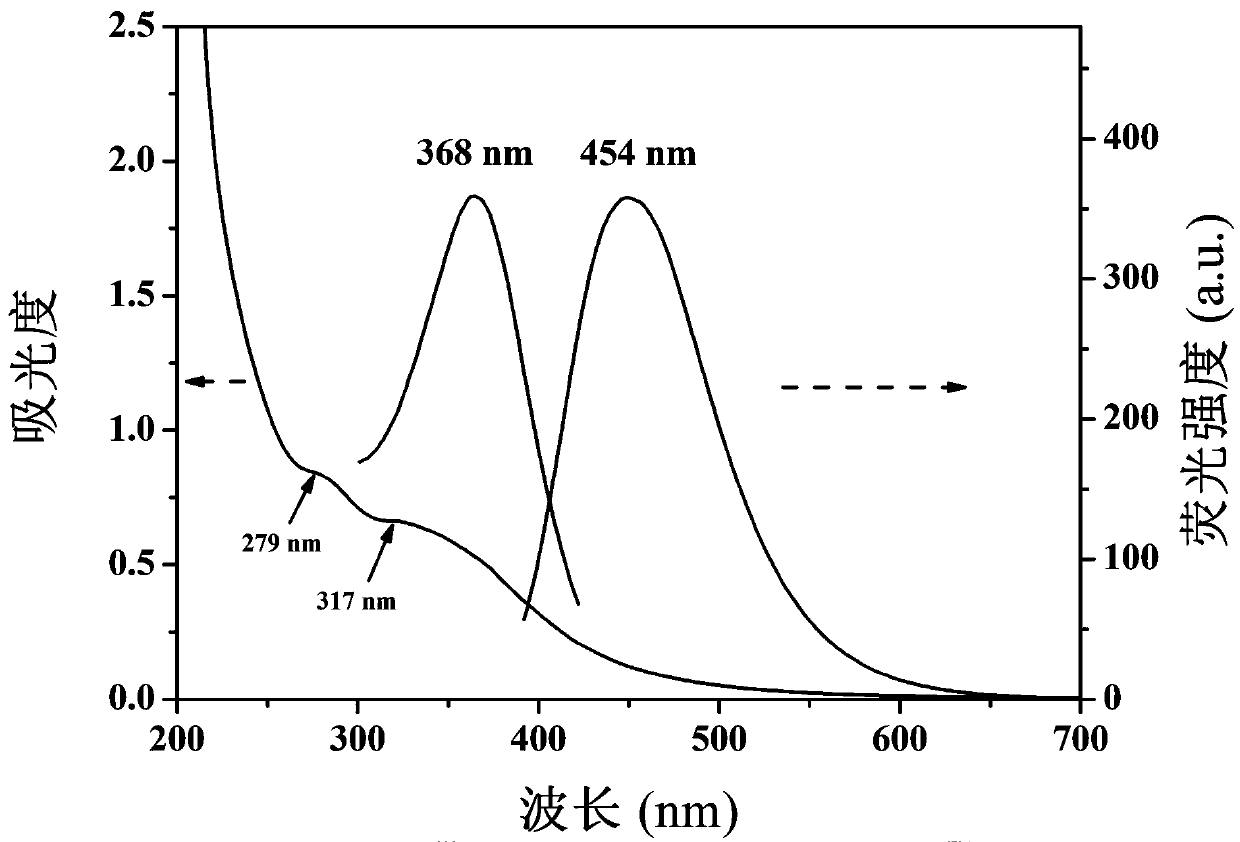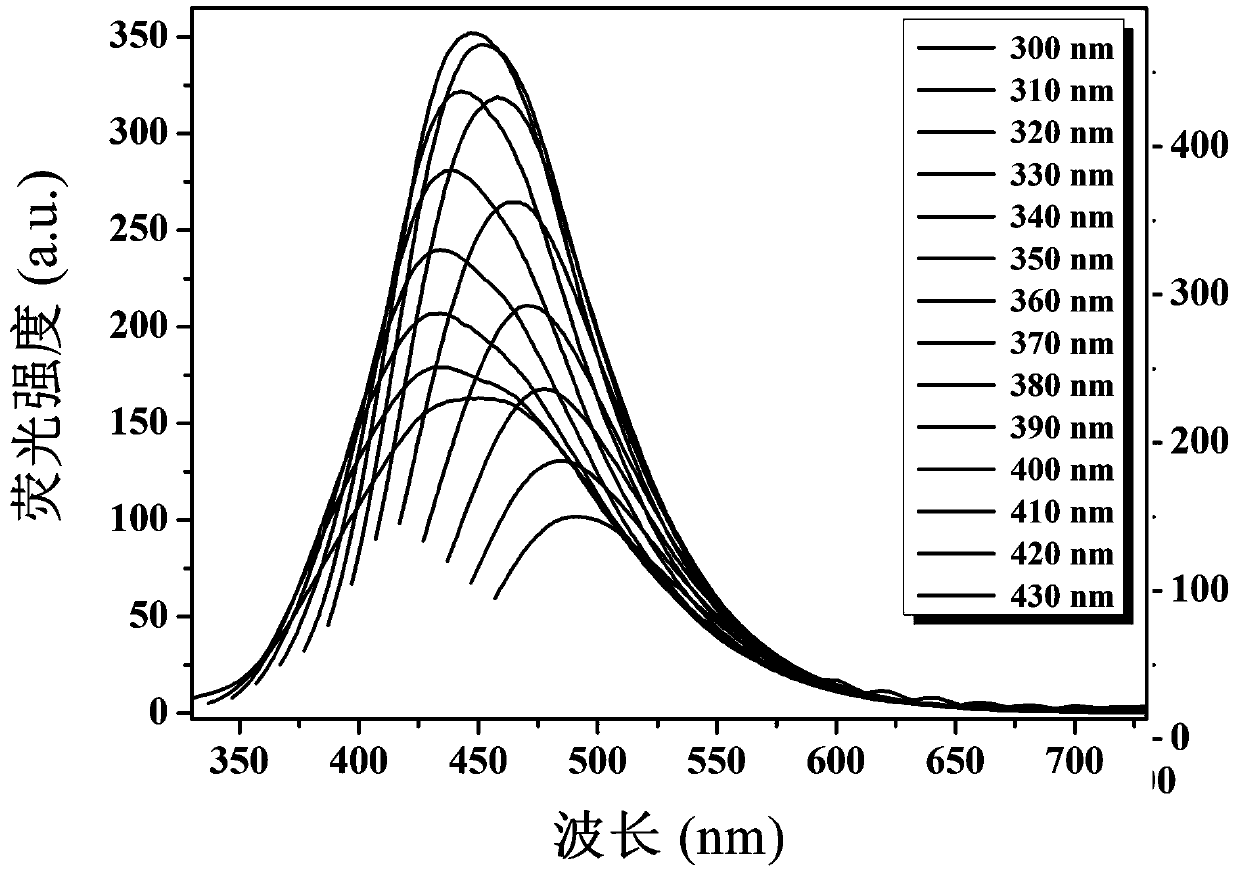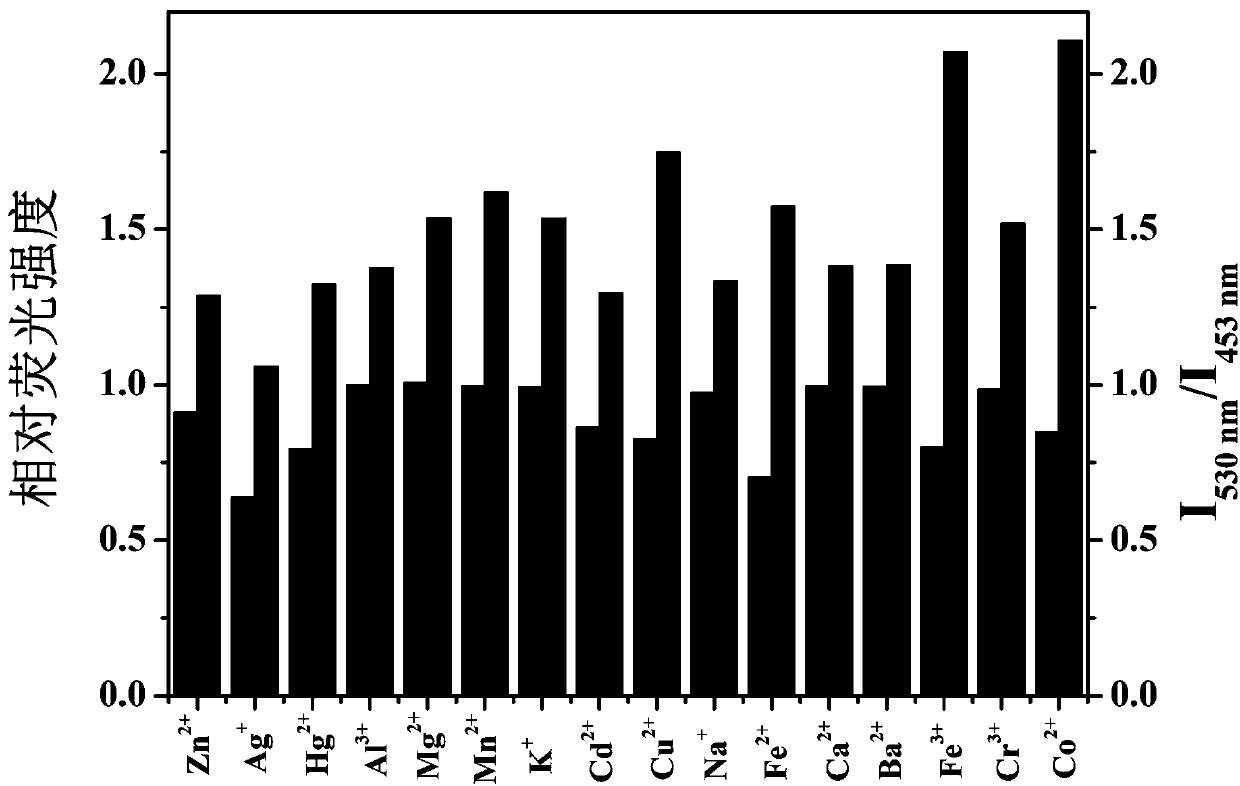Fluorescent probe for quantitatively detecting riboflavin on basis of fluorescence resonance energy transfer ratio, and preparation method and application for fluorescent probe
A fluorescence resonance energy, quantitative detection technology, applied in the field of fluorescent probes, can solve the problems of weak anti-interference ability, cumbersome steps, time-consuming and laborious, etc., and achieve high accuracy and sensitivity, simple preparation method, and strong anti-interference ability. Effect
- Summary
- Abstract
- Description
- Claims
- Application Information
AI Technical Summary
Problems solved by technology
Method used
Image
Examples
Embodiment 1
[0029] Embodiment 1: Preparation and characterization of NPCl-CQDs
[0030] Step 1: Weigh 0.4 g of glucose, add 6 mL of ethylenediamine, 2 mL of concentrated phosphoric acid and 2 mL of concentrated hydrochloric acid to it to obtain a brown viscous substance.
[0031] Step 2: After the beaker was cooled to room temperature, 30 mL of ultrapure water was added to it, stirred to fully dissolve, centrifuged at 4000 rpm for 10 minutes, and the supernatant was filtered with a filter membrane to obtain a clear NPCl-CQDs solution.
[0032] Step 3, freeze-drying to obtain solid powder of NPCl-CQDs.
[0033] Step 4: Weigh 0.1 g of NPCl-CQDs solid powder into a beaker, add 10 mL of ultrapure water to it, and ultrasonically dissolve it fully to obtain a stock solution of NPCl-CQDs with a concentration of 10 mg / mL.
[0034] Characterization see figure 1 and figure 2 . figure 1 In the UV absorption spectrum of NPCl-CQDs, there are two obvious absorption peaks located at 279 nm and 317 ...
Embodiment 2
[0035] Embodiment 2: Anti-interference experiment of riboflavin detection
[0036] Step 1: Accurately weigh a certain mass of metal ions (Fe 3+ , K + , Fe 2+ , Mg 2+ , Cu 2+ , Al 3+ , Ag + , Ca 2+ , Cr 3+ , Na + , Mn 2+ , Zn 2+ , Hg 2+ , Cd 2+ , Ba 2+ ,Co 2+ ) compound, add 10 mL of ultrapure water, and ultrasonically dissolve to prepare a metal ion stock solution with a concentration of 0.1 mol / L.
[0037] Step 2: Accurately weigh a certain mass of amino acids (valine, phenylalanine, threonine, arginine, alanine, leucine, isoleucine, tryptophan, glycine, serine, semi- cystine, tyrosine, histidine, lysine, glutamic acid, aspartic acid, glutamine, methionine, proline, homocysteine, glutathione), Add 5 mL of ultrapure water, ultrasonically dissolve, and prepare an amino acid stock solution with a concentration of 0.01 mol / L.
[0038] Step 3, accurately weigh a certain mass of anions (Br - , I - , F - , CO 3 2- , S 2 o 3 2- , HCO 3 2- , SO 3 2- , NO ...
Embodiment 3
[0045] Embodiment 3: the linear equation of riboflavin titration NPCl-CQDs
[0046] Step 1, measure the fluorescence intensity of NPCl-CQDs (0.57 mg / mL), record the fluorescence intensity of NPCl-CQDs at 530 nm and 453 nm, respectively, denoted as I 530 nm and I 453 nm , and calculate the ratio I 530 nm / I 453 nm .
[0047] Step 2: Add riboflavin stock solution drop by drop, and record the fluorescence intensity of the mixed solution of NPCl-CQDs and riboflavin at 530 nm and 453 nm, respectively, as I 530 nm and I 453 nm , and calculate its ratio I 530 nm / I 453 nm . Changes in fluorescence intensity see Figure 7 .
[0048] Step 3, using Origin software, fitting the fluorescence intensity ratio of NPCl-CQDs and riboflavin mixed solution at 530 nm and 453 nm ( I 530 nm / I 453 nm ) and riboflavin concentration, a linear equation is obtained, and the results are shown in Figure 8 and Figure 9 .
[0049] Figure 7 It shows that with the addition of ribo...
PUM
| Property | Measurement | Unit |
|---|---|---|
| concentration | aaaaa | aaaaa |
Abstract
Description
Claims
Application Information
 Login to View More
Login to View More - Generate Ideas
- Intellectual Property
- Life Sciences
- Materials
- Tech Scout
- Unparalleled Data Quality
- Higher Quality Content
- 60% Fewer Hallucinations
Browse by: Latest US Patents, China's latest patents, Technical Efficacy Thesaurus, Application Domain, Technology Topic, Popular Technical Reports.
© 2025 PatSnap. All rights reserved.Legal|Privacy policy|Modern Slavery Act Transparency Statement|Sitemap|About US| Contact US: help@patsnap.com



